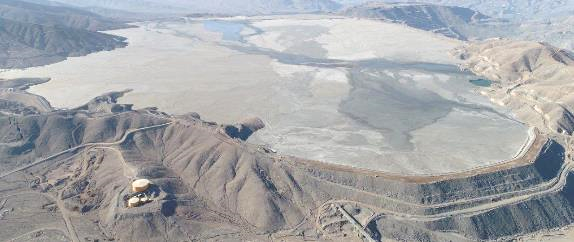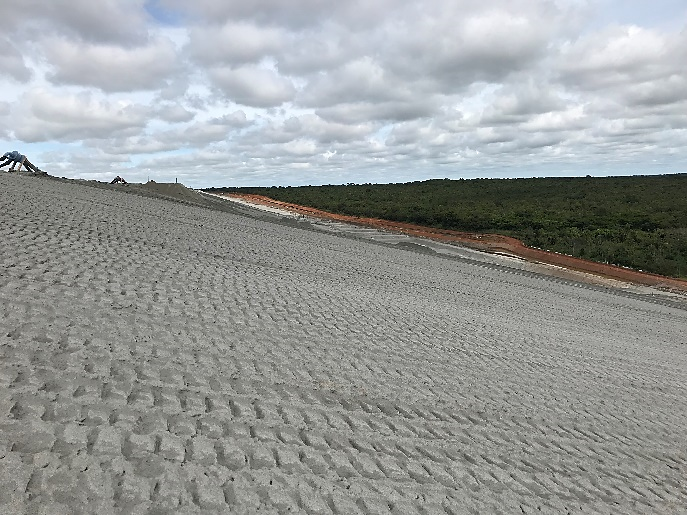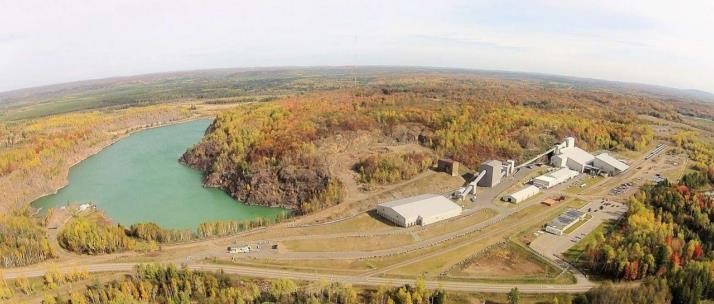Environmental Stewardship
We commit to climate action, strengthening water and waste management, and biodiversity conservation to contribute to a more sustainable environment for us all.

Effective environmental management is integral to the success of all of Lundin Mining’s operations, from day to-day activities on-site, to corporate strategic planning. Lundin Mining’s operations are committed to compliance with applicable laws and regulations, our Responsible Mining Policy and framework and our Responsible Mining Management System (RMMS). This standard is an auditable specification outlining mandatory requirements for management systems to be implemented at all Lundin Mining Sites for the management of the HSEC aspects of our business.
Our primary objective is to minimize potential environmental impacts through implementation of environmental management controls and procedures that are tailored to meet the individual needs of each of our operations in their unique environmental settings. We achieve this through effective use of environmental impact assessment to identify, quantify, and eliminate or mitigate impacts; integration of environmental controls within our operations, with monitoring to evaluate their reliability and effectiveness, and to identify potential opportunities for improvement; employment of risk assessment and management techniques to minimize the potential for unforeseen environmental impacts or incidents; and routine checking and continuous improvement through the annual environmental audit process. In 2019, Lundin Mining developed a climate adaptation and mitigation planning toolkit which is being used throughout the Company to assess risks and opportunities.

Tailings Management
-
Our Approach
Lundin Mining is committed to the safe and responsible management of tailings facilities, to emergency preparedness and response, to post-incident recovery, to compliance with applicable legislative and regulatory requirements, permit conditions, and to our Code of Conduct, Ethical Values and Anti-Corruption Policy.
Lundin Mining employs a comprehensive and integrated approach to tailings management. This provides us with confidence that potential safety, environmental and social impacts can be reliably identified and minimized.
Our operations aim to minimize associated risk with a clear understanding of the tailings characteristics, the facility construction materials, and the final settings in which they are placed.

Candelaria Tailings Facility at the Candelaria Copper Mining Complex in Chile -
Our Facilities
Lundin Mining operates four mines with five active tailings facilities and uses the widely accepted method of surface tailings disposal. This involves placement in engineered surface impoundments or, in the case of Eagle, in a previously mined open pit.
Of the four Lundin Mining operations, Eagle Mine is the only operation that does not have a constructed tailings impoundment with dams.
Across the other operations, the active tailings facilities use various construction techniques for the main and secondary or perimeter dams. Lundin Mining also maintains and monitors five inactive/closed tailings facilities.
All tailings facilities are operated or closed as per the currently approved design. Full and complete engineering records including design, construction, operation, maintenance and/or closure exist for all tailings facilities except for the closed Ojos del Salado facilities at the Candelaria Mining Complex. The three Ojos del Salado tailings facilities are legacy sites that ceased operations in the 1960s. The Ojos del Salado tailings facilities were fully closed in 2012 as per an approved engineered closure plan.
A full list of tailings facilities that Lundin Mining manages, including information on tailings management, construction method, maximum dam height and volume, can be found in our Tailings Management Information Sheet.
-
Tailings Management
Surface tailings impoundments can represent some of the most significant safety and environmental related risks for the mining industry. Lundin Mining takes considerable care to ensure our tailings facilities have robust and resilient designs, built in accordance with leading industry practices and standards, well operated and maintained, inspected, independently reviewed, and carefully monitored.

Chapada Tailings Facility at Chapada in Brazil Policies and Standards
Lundin Mining’s Responsible Mining Policy and Responsible Mining Management System (RMMS) include tailings specific principles and standards. All Lundin Mining’s operations manage their tailings in accordance with the Tailings Management Standard, updated in 2021 to align to the Global Industry Standard on Tailings Management (GISTM).
The Tailings Management Standard requires that for all tailings facilities throughout the entire lifecycle, from planning and design, construction, operation, closure, and post-closure, implementation of leading practices will be carried out to:
- Protect the health and safety of our people and host communities;
- Minimize harm to the environment;
- Ensure all aspects comply with Lundin Mining policies and standards and accepted international practice;
- Ensure all aspects comply with commitments to stakeholders; and
- Ensure leadership, personal commitment, and accountability from all employees, consultants, and contractors is embedded throughout all aspects of tailings management.
Goverance
Lundin Mining’s oversight of all tailings facilities includes a three lines model. The first line starts with the operational management and engineering teams at the sites which includes a Responsible Tailings Facility Engineer.
At the corporate level, Lundin Mining has a specialized tailings team, which serves as a dedicated technical resource for the site operators and engineers and serves as the second line. The corporate team does not have day-to-day operating pressures and exists to provide assurance and technical leadership related to tailings management.
For assurance, the corporate team manages the Independent Tailings Review Board (ITRB) program and works closely with the sites and external Engineers of Records to make sure any recommended actions are completed in a timely manner. This team develops guidance and tools that support consistent implementation of the Tailings Management Standard across the company. The team also stays abreast of current and emerging technologies and leading international practices around tailings facility design and management. The corporate team provides advice to the sites and supports the Accountable Executive by communicating on assurance activities and any findings as well as preparing Board materials.
As a third line, the corporate team arranges audits to verify consistent implementation and conformance with the Tailings Management Standard including the relevant management systems to assure effectiveness.
Monitoring and Surveillance
A requirement of the Tailings Management Standard is for all operations to conduct regular geotechnical, hydrogeological, and environmental monitoring to meet regulatory requirements and prevent the uncontrolled release of tailings and/or water to the environment.
All operations employ monitoring and surveillance systems which may include surface prisms, piezometers, inclinometers, remote sensing and other technologies to monitor tailings dams and water levels. Trigger action response plans (TARPs) provide clear guidance on how to respond to pre-determined trigger levels for surveillance activities.
All tailings facilities have a closure plan which includes long-term monitoring requirements. The monitoring plan for the closed Ojos del Salado tailings facilities at the Candelaria Mining Complex was reviewed in 2021 and additional dam safety instrumentation was installed.
Responsible Tailings Facility Engineer
All operations are required to identify a responsible person to ensure ownership and proper management of the tailings facility. The Responsible Tailings Facility Engineer (RTFE) ensures procedures for each facility, including an Operating, Maintenance, and Surveillance (OMS) Manual and Emergency Preparedness and Response Plan, are regularly documented, and made available to operations personnel. The responsible person is an appropriately qualified, experienced, and site-dedicated individual employed directly by the operation.
Staff Inspections
Tailings dams are regularly inspected by trained operators and technical staff, sometimes as frequently as several times daily, with formal documented staff inspections at least quarterly.
Engineer of Record
Each tailings facility has an appropriately qualified, licensed, and experienced third-party geotechnical engineer to act as an Engineer of Record in the relative jurisdiction.
Dam Safety Inspections and Performance Reviews
Formal dam safety inspections are conducted at least annually by the Engineer of Record, and reports are issued to the RTFE for action on recommendations.
Dam Safety Reviews
Independent dam safety reviews are conducted by qualified multi-disciplinary technical specialists as frequently as every five years.
Independent Tailings Review Boards
Lundin Mining’s Tailings Management Standard includes a requirement for regular independent third-party tailings review boards, which are recognized as a leading practice for effective tailings management.
ITRBs were established for all tailings facilities in 2022. In addition to the annual site visit, online progress meetings with the ITRBs and Engineer of Record are completed throughout the year to closely track progress made on outstanding recommendations.
-
Global Industry Standard on Tailings Management
Lundin Mining is committed to the implementation of the GISTM, which is the first global standard on tailings management.
The Lundin Mining Tailings Management Standard was updated in 2021, and the Responsible Mining Policy was updated in 2022 to align with the GISTM requirements. In 2022, Lundin Mining completed third party gap assessments against the GISTM, and by 2023, achieved full GISTM conformance for the active tailings facilities across Candelaria and Chapada.
In 2024, Lundin Mining achieved full GISTM conformance for both active facilities at Caserones. Lundin Mining's active tailings facility at Eagle, which is classified as a lower-consequence facility, is expected to conform with the GISTM in 2025.
Learn more:
- Candelaria Los Diques Tailings Facility GISTM Public Disclosure Report
- Caserones La Brea Tailings Facility GISTM Public Disclosure Report
- Caserones El Tambo Tailings Facility GISTM Public Disclosure Report
- Chapada Tailings Facility GISTM Public Disclosure Report

Humboldt Tailings Facility at Eagle in USA


